Understanding Thickeners in Liquid Soap
Liquid soap has gained immense popularity over the years, not just for its cleansing abilities but also for its versatility and convenience. One of the crucial components that contribute to the quality and usability of liquid soap is thickeners. In this article, we will explore the role of thickeners in liquid soap, their types, and their significance in creating an effective and marketable product.
What Are Thickeners?
Thickeners are substances that increase the viscosity of a liquid solution without altering its other properties. In the context of liquid soap, thickeners help create a desirable thickness that enhances usability and improves the overall user experience. The right thickness ensures that the soap adheres to the skin effectively during cleansing, providing a luxurious feel while in use.
Importance of Thickeners in Liquid Soap
1. Texture and Feel The primary reason for using thickeners in liquid soap is to achieve a preferred texture. A thicker soap formulation feels more substantial and luxurious, encouraging consumers to associate the product with quality. On the other hand, a soap that is too watery may give the impression of being diluted or less effective.
2. Stability Thickeners contribute to the stability of liquid soap formulations. A stable product ensures that the ingredients do not separate over time, maintaining a consistent appearance and performance. This is particularly crucial for commercial products that need to have a longer shelf life and remain visually appealing to consumers.
3. Application A thickened liquid soap is easier to dispense and control during application. Consumers prefer products that they can apply without excessive dripping or mess. The right thickness allows the user to dispense the desired amount, minimizing waste and enhancing the overall experience.
4. Effectiveness Thicker liquid soaps can improve the effectiveness of cleansing actions. A viscous formula allows for better adherence to the skin, providing concentrated cleansing and moisturizing benefits. This can be particularly important in formulations designed for sensitive skin or therapeutic purposes.
thickeners liquid soap

Types of Thickeners
There are numerous thickeners available for liquid soap formulations, each providing unique properties and benefits. The most commonly used thickeners include
1. Natural Thickeners These include ingredients derived from plants and can be a great option for organic or natural soaps. Examples include xanthan gum, guar gum, and carrageenan. They are generally safe, biocompatible, and can offer additional benefits such as soothing the skin.
2. Synthetic Thickeners These are chemically manufactured substances that provide effective thickening capabilities. Common synthetic thickeners in liquid soap include polyacrylate and carbomer. While effective, some consumers may prefer natural alternatives due to concerns about synthetic ingredients.
3. Glycerin Though often used as a humectant, glycerin also provides some thickening properties. It attracts moisture and helps to improve skin feel, making it a good additional component in liquid soap formulations.
Challenges and Considerations
While thickeners are essential in formulating liquid soap, it is vital for manufacturers to strike a balance between viscosity, stability, and performance. Over-thickening can lead to challenges such as difficulties in dispensing or uneven application. Furthermore, the choice of thickener may also affect the sustainability and consumer acceptance of the product, particularly in an era where eco-friendliness is a significant consideration for customers.
Conclusion
Incorporating thickeners in liquid soap is essential for achieving the desired texture, stability, and overall performance of the product. Understanding the different types of thickeners and their benefits allows formulators to create high-quality liquid soaps that cater to consumer preferences. As the market for liquid soap continues to evolve, the importance of effective and sustainable thickening agents will undoubtedly remain a key consideration in product development.
-
Rdp Powder: Key Considerations for Wholesalers in the Building Materials IndustryNewsJul.08,2025
-
Key Considerations for Wholesalers: Navigating the World of Hpmc - Based ProductsNewsJul.08,2025
-
Hpmc Detergent: Key Considerations for WholesalersNewsJul.08,2025
-
Key Considerations for Wholesalers: China Hpmc For Tile Adhesive, Coating Additives, Concrete Additives, and MoreNewsJul.08,2025
-
Crucial Considerations for Wholesalers: Navigating the World of Construction MaterialsNewsJul.08,2025
-
Key Considerations for Wholesalers Sourcing Additive For Cement, Additive For Concrete, Additive For Putty from Additive Manufacturer Shijiazhuang Gaocheng District Yongfeng Cellulose Co., Ltd.NewsJul.08,2025




